|
The Hidden User Account Control Dialog of DOOM!!!This happens every few weeks as I recklessly install junk in the Komputer Attik: I’ll be in the middle of the usual dog’s breakfast of debris — iTunes, say — and it’ll “hang up”. Stop at “looking for frogs” or whatever idiotic message they show, and do nothing. I usually put a stopwatch near the keyboard, and when it goes over four minutes I figure it’s toast and cancel. This happens infrequently enough that I forget it’s just Windows 7, or the frolicksome Vista before it, playing hide and seek! ... A symptom is the task bar, which I normally keep hidden, refusing to hide! It does this, of course, because there’s a little tiny icon there of the saintly UAC; it goes “mmmph mmmph” because some evil being — that is, the moronic Windows — has trapped it on the task bar, and it cannot speak! The poor little thing.... I mean, I know I’m not the only one who gets these marvelous things. But I google “hidden User Account Control” and nothing. Because all across the fruited plains people just give up; or they reboot and do it again — which is actually what I did, but after killing the stupid install — and try again, whereupon frequently the UAC will condescend to appear before our mortal eyes. ... Or actually, most likely, everyone’s turned-off UAC long ago! Only I still humor the cranky wacko! ... It’s just garbazh; it’s all junk, and it’ll be gone soon, and the wonderful geeky lovable cretins responsible have absolutely no clue of how to do anything, and then shockingly their enterprises grow moribund and they decay and sink away into the darkness of inevitable commercial eclipse. ... And Oh I forgot to rant the most annoying obvious thing: the geeks who create this tripe operate their stupid computers without UAC! Of course they do, just like all the Unix/Linux geeks always use root, despite all their lying solemn assurances. ... After all, the company pays, and even if the geek’s computer gets infested up the kazoo, they just “reimage” it from some magic corporate server, no problem! ... It’s so easy if you’re a geek insider without care or concern or the slightest desire to test anything....
|
|
|
 A
$20 Casio
A
$20 CasioIncidentally if you actually want a scientific calculator, the Casio “fx-115ES PLUS” I just got for $18 at Walmart is undoubtedly more than enough for any mortal. And has hex/bin/octal calculations; the $12 and $8 Casios didn’t. ... Although it does have a weird tendency to render its results in regular fractions....
 — the
maybe not so
well-balanced programmer
— the
maybe not so
well-balanced programmer
9/17
Mon 9/6/21 8:47 am. And then, after buying four of these fx-115 casio calculators over the years, ’cause they’re so cute, I finally broke down and downloaded the manual to find-out that I can display the ridiculously-persistent regular fraction results in honest decimal with the EZ-PZ “shift + =” keystrokes! ... And helpfully demonstrating the stupid white guy phenom is by no means limited to the land of the free and the home of senile communism....
 My
very own HP35,
rescued from the dust bin of history....
My
very own HP35,
rescued from the dust bin of history.... Or
at any rate, from Adamstown
PA Mad Hatter
for $119 at the calculator guy’s booth — actually he appears
to be the
Mad Hatter “science guy”, although I’ve only bought the
occasional
slide rule
over the years. ... The hp35 in its natal moment was $395,
dwindling to $195 as the weary years stumbled on, so my ~$150
(including
my add-on ebay battery) is still a marvelous bargain.
Or
at any rate, from Adamstown
PA Mad Hatter
for $119 at the calculator guy’s booth — actually he appears
to be the
Mad Hatter “science guy”, although I’ve only bought the
occasional
slide rule
over the years. ... The hp35 in its natal moment was $395,
dwindling to $195 as the weary years stumbled on, so my ~$150
(including
my add-on ebay battery) is still a marvelous bargain.
... But oh the glorious hp35! With its original plastic case, and a note advising me to buy an ebay battery for it, which I did, for a mere $17, and now the ridiculous artifact lights-up its tiny red LEDs into the fading sunset of onrushing covid variants, as progressive & decent people everywhere desperately try to hold on to power....
The battery pack contains three NiMH AAAs, and I can recharge or replace ’em, probably, and so my entirely useless but unspeakably charming HP35 will live on as long as Owenlabs shall last!
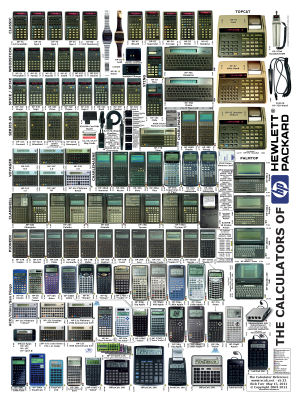 And
I celebrated my amazing acquisition by blowing $30 or so on a
beautiful
high-quality plastic-like poster
of the entire HP calculator oeuvre.
And
I celebrated my amazing acquisition by blowing $30 or so on a
beautiful
high-quality plastic-like poster
of the entire HP calculator oeuvre.
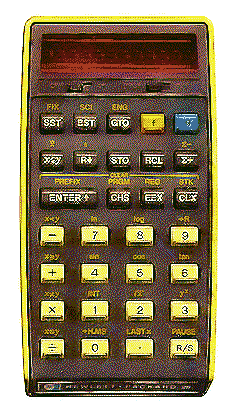 And at
last, the ~1976 HP25
And at
last, the ~1976 HP25But my truly sacred Hewlett-Packard calculator was the beautiful HP25 which I yearned-for, hopelessly, in my frozen days in the north, in the land that time forgot — well actually in the bookstore near Cornell — not the Cornell bookstore, which had its charms, but not this — no, the privately-owned high street bookstore which carried an exciting range of HP calculators including in its appointed time the HP25, transcendently cute. (I am informed by my cult historian it was the “Triangle” book store what closed in 1998, although it may have run out of HP calculators before then.)
The beautiful HP25 has the slanted key tops with numerous secondary & tertiary functions (memorialized in the end times by the 35s), and it was this calculator which drove my pitiful cheapo calculator purchasing program, finding treasures at Woolworth’s (!) and elsewhere, which were “as good” as the HP25, which they certainly were, in terms of functionality.
Although the 25 had useless programmability — useless ’cause you had to re-enter it every time it power-cycled, which sorrow was supposedly fixed with the HP25C for “CMOS”, so your tediously-entered program’s future only depended on the reliability of the Hewlett Packard power supplies. ... I paid something near $300 for my HP25 @ a kindly ebay vendor, which is still less than its extortionate fare in the day (wikipedia says it was $195 in 1975, more-or-less equalling $894.39 in today’s biden dollars).
And the HP25’s reception @ owenlabs was not without angst: the adorable thing refused to light-up until I begged it with deoxit and obscure incantations, but now it seems to be getting along fine with NiMH batteries ... I guess the electrons were tired after all these years. ... Maybe someday I’ll try & program it, with a downloaded PDF manual — what has premium color printing! ... In antiquity I first learned programming with HP’s cheapo competition the TI59, after which 8080 assembly language at Ithaca Audio was a piece of cake....
 The Calculators
The CalculatorsIn my time, I have walked among calculators in their numbers, lit-up on all side in beauty & confusion. ... After the thrill of my HP35, I remembered vaguely that I had other expensive HP calculators — the $150 flavor, not the HP35 kind — an HP28C or something — and then, slapping the forehead cartoon-like, I realized of course I had it, and others; on display, in the garage!
My antique HP28C was broken, of course. I probably removed the batteries from my other working innocents sometime in the 90s, but just now the HP28C, being a proud murican product, the battery door was jammed shut, with rotting batteries. Actually if I hadn’t developed rotting battery expertise in the intervening years with the silly cameras, I wouldn’t’ve got so far as seeing the rotten batteries. And doubtless my first estimate, what I discovered in the ancient times — not worth the bother — is just as valid today.
Because the sad thing about many HP calculators, as I may have inadvertently hinted in a previous diatribe, is they were dumb. ... I easily found a pdf manual for my HP28C, and in that manual there is NOT ONE WORD ABOUT BATTERIES! NOTHING. ... Why would you want to know that, eh, pilgrim? ... Because we deliberately designed the stupidest battery system we could? Because we knew it never worked? ... No, of course not. The ever-popular alkaline N cells are just the ticket for your fancy programmable which is, after all, just a stupid toy for stupid geeks we gulled you into buying, because in those days zillions of oriental programmable calculators were $12.39 @ Woolworth’s. ... Oh yes.
... Well actually now that I think about it, there are
rechargeable NiMH N-cells![[1]](one.png) , and if I ever drill out my 28C,
that would
be cute, and they usually don’t rot — at least, the other NiMHs
haven’t
yet. ... Well, actually, it turned-out there weren’t a lot; I guess
the towering success of HP in the field had its effect....
, and if I ever drill out my 28C,
that would
be cute, and they usually don’t rot — at least, the other NiMHs
haven’t
yet. ... Well, actually, it turned-out there weren’t a lot; I guess
the towering success of HP in the field had its effect....
 But
Oh Too
Beautiful
But
Oh Too
BeautifulBut just like I was ranting about in my murican tuning junk adventures, when I see the beautiful calculators on the fellow’s chart, my heart swells at how lovely they all are, even ’though some of them are so exquisitely broken in the pitiful we’re-so-smart ridiculous hallowed murican Tao of incompetence.
... And then, in the time of the Biden Afghanistan Triumph, I brought my ridiculous hp28C back to glorious sputtering life. It woke-up, and pitifully reported “lost memory” ... I’ll bet. ... Some bullet points:
As usual, I poured some 3-in-1 oil into the battery compartment / frozen batteries. When assaulting my cameras, I’m always in a silly hurry, but for some reason this time not so much, and the pitiful machine lay resting for a day or two, and then, although I started to drill the battery out, preparatory to inserting a self-tapping screw to pull it out, that was unnecessary as the pitiful corroded battery bounced on the battery compartment springs, and eventually came out just with an exacto knife to poke and pull it a bit.
Of course it should be noted that pouring 3-in-1 oil into a battery compartment may avoid any further need for maintenance/repair. In the 3 or four cameras I’ve done this to, and now the 28C, damage has been limited to the gadgets feeling oily....
I then proceeded to clean the battery door, the little piece of plastic which, in such atrocities as the HP28C, usually breaks and cannot be replaced within our mortal lives. Luckily I managed to avoid that, presumably accidentally, although I did use my almost-magical watch pry bar tool to gently get it open. ... Using a dental scraping tool and other junk including a battery-powered toothbrush, surprisingly useful, I disciplined the little metal part of the plastic door which was supposed to slide into the calculator, and I made it go pretty good: when begun, it was definitely sticking, but when I finished I could push it in and out without major force.
But with a more-or-less working battery door, getting my charged-up N-cell batteries in was still a major operation, as I remember from antiquity. In asummary, it was just stupid: one has to push the positive-nipple sticking-out cell down enough, with a fingernail or some miniature protuberance, and gently carefully push the stupid door closed. This is the normal procedure!!! ... Lucky HP calculator buyers! ... And oh yes, the manual — the one that actually describes the procedure, I believe it’s the HP18 manual, instead of the later (!?) 28c manual which observes omerta — proclaims that if you don’t do it fast enough, you’ll lose your important programmed memory thingeys or something....
So there you have it; the end of history in our time. ... And oh yes the 28C could do programming although even I wasn’t crazy-enough for that; by the time I bought the thing, I was already in collector-mode. By 1987 I believe the Kaypro II was already 2 or three years old, and obviously only a lunatic would program on one of the HP ridiculosities although their numbers were legion — largely I believe the pitiful hardware engineers, who in my time were already deeply resentful of geeky creeps like myself who actually made more money with this stupid software racket — and one of their pitiful solutions was to turn to these marvelous gadgets that would somehow “program” without a computer. ... And indeed, I myself learned programming with my beloved TI59, smoking cigarettes and collecting unemployment in those golden days in the frozen North — although the minute Ithaca Audio and the microcomputer turned-up, I never looked back....
And of course HP today isn’t down in the dirt; there are still selling pitifully-broken HP laptops, and their laser printers march on into the night....
 The
Truly Mediocre HP19BII
The
Truly Mediocre HP19BIIIn a final triumph of dubiety, I lit up my HP19BII — this model was made to punish the bizness types for over-reaching and wishing to know mortgage returns without a banker. It’s an earlier unit than the astonishingly-stupid HP28C, and it shows this by barely holding together physically. At least my example has lost all the left-side keys — I remember them falling-out some years ago with a gentle raining noise — which I confined in a little plastic box and now, in the end times, I’ve confined parts of the left keyboard plastic frame and some of the plastic overlays, into a plastic bag from which they will probably never escape. And I don’t think I’ve got it together right yet — I think the right-side keyboard is seeking its freedom, too. ... But it did proclaim “memory lost”... several times. ... Now I will remove its rechargeable N cells, probably for the last time. ... After all, I’ve got a TI59 in the garage with a lock I want to drill-out to destruction....
But
the HP19BII is still for sale @ amazon, from the always-dubious “these
sellers”, from $150 & up, used of course. ... Buy the $55 HP12C
if
you really must have an HP financial calculator; it’s still for sale
new and, in my experience, has worked
several times, and is beautiful.
... & apparently the HP19, like the HP12, isn’t
programmable. ...  But
someone’s still buyin ’em, at amazon....
But
someone’s still buyin ’em, at amazon....
So I went and bought the predecessor HP financial calculator (~1986) for $35 @ ebay which, oddly, actually works. It has the same pathological N cell batteries, but the manual at least describes changing them without pretending it’s easy. The ebay seller “emt7978” included alkaline Ncells so it actually lit-up when I pressed the ON button, but of course I swiftly changed ’em to my new-age never-rotting-I-hope NiMH N cells. It has the adorable little slanted keys — but nothing written on the slanted part! ... Don’t want to get those MBAs clutching their pearls.
... You understand, as far as I know the HP18C is totally useless, as was the 19B and the 28C. I’m not an MBA thank goodness, or even an engineer, but a software engineer, and of course I did occasionally use a hex calculator in those golden days, but never the lovable HP16. ... So the N-cells go into my general NiMH store, and the HP18 to the garage of beauty and batteryless-calculators, where they will live out a fascinating life as I occasionally stumble out there keeping track of things....
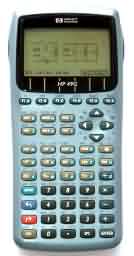 The
2003
HP-49g
The
2003
HP-49g(12/23) It was ~$60 used at Ebay, and a thing of wonder & beauty. 2003 was in the HP struggle years, before the out-of-business years, while HP pitifully fought the vicious foreigners — in Japan & Texas — for calculator supremacy. And of course lost. ... And in the stupid white guys eternal battle against providing competitive hexadecimal computation, the 49g apparently provides a full roster of hex digits, but I can’t find in the manual how to use them! — that’ull learn you, you jap calculator traitor. ... So googling for “hp49g hex” or something, I got this:
First set hex mode by pressing HEX. You can get the command HEX for example by pressing the keys [blue-shift], [CONVERT] (key 6), [F2], [F1]. When HEX mode is on all binary integers are displayed in hexadecimal. Now enter your number and then press R->B. You access the command R->B by pressing the keys [blue-shift], [CONVERT] (key 6), [F2], [F5].
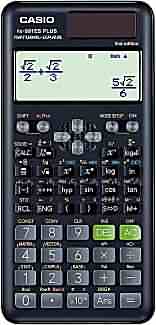 But that
didn’t seem to actually work — and I think the question was
how to convert
from decimal to hex or maybe visa versa. Or who knows? I wound-up with
a “hex” legend on the top of the screen but still no idea how
to enter
hex numbers;
probably requires 37 keystrokes as with other HP genius calcs. ... So
convenient. ... And my “standard” calculator casio fx-991d
($30
in
1992) could just do hex arithmetic without elaborate petitions or
crawling on the floor. Sadly the 991d is no longer with us, although I
own numerous instances; a probable successor the Casio FX-991ES is ~$30
today at amazon with a multi-line display, i.e. kind-of like the 49g,
but probably works — and it’s got easy hex arithmetic!
But that
didn’t seem to actually work — and I think the question was
how to convert
from decimal to hex or maybe visa versa. Or who knows? I wound-up with
a “hex” legend on the top of the screen but still no idea how
to enter
hex numbers;
probably requires 37 keystrokes as with other HP genius calcs. ... So
convenient. ... And my “standard” calculator casio fx-991d
($30
in
1992) could just do hex arithmetic without elaborate petitions or
crawling on the floor. Sadly the 991d is no longer with us, although I
own numerous instances; a probable successor the Casio FX-991ES is ~$30
today at amazon with a multi-line display, i.e. kind-of like the 49g,
but probably works — and it’s got easy hex arithmetic!
... But of course the 49g is programmable, and the 991es isn’t. As noted elsewhere in this astonishing memoir, I learned how to program on a texas instruments TI59 in 1977 and it was wonderful, but that was years before we got real home computers and, now at least in the US, everybody has one or more PCs — but in lesser poverty-stricken lands like Europe, the student apparently still yearns for a programmable calculator or at least Casio might sell them there, but not in the US so much anymore. ... But the casio programmable calcs I looked at apparently still provide EZ-access hexadecimal. ... Another factor is the standardized US college tests (SAT etc.) would prohibit the use of programmable calculators, and for years that was the big calculator market when the kids bought the permitted calculators for the big test.
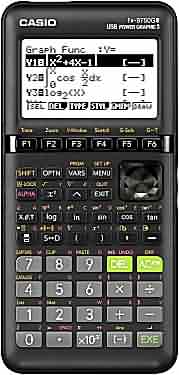 ... To
demonstrate the obvious superiority of the
casio hex wrangling I bought a programmable
casio fx5800p with
hex, ~$100.
... However, painfully it was DOA
and I discovered, via ebay spelunking, that all
the fx5800p were like
that — there were numerous fx5800ps “new in box”
for about $100, but none
“used
tested”. ... So I returned mine to amazon and bought a cheaper $60
Casio fx-9750GIII which was
programmable
— in python! it says — and worked wonderful! ... Well I haven’t
tried
the programing but it has the right keys and I could get it to do
hex arithmetic without major calamity, and so all is perfect &
serene....
... To
demonstrate the obvious superiority of the
casio hex wrangling I bought a programmable
casio fx5800p with
hex, ~$100.
... However, painfully it was DOA
and I discovered, via ebay spelunking, that all
the fx5800p were like
that — there were numerous fx5800ps “new in box”
for about $100, but none
“used
tested”. ... So I returned mine to amazon and bought a cheaper $60
Casio fx-9750GIII which was
programmable
— in python! it says — and worked wonderful! ... Well I haven’t
tried
the programing but it has the right keys and I could get it to do
hex arithmetic without major calamity, and so all is perfect &
serene....
— the antique programmer
in the years of eternal covid
2021
& onwards
1. Well there were rechargeable N cells, once in days of yore. ... I bought some obviously dubious new ones from amazon, but of an NiMH N-cell recharger, including my apparently precious Odec Model OC-503, not a trace. Probably they only existed to service the extremely-stupid-HP-calculator market. ... Probably a “regular” NiMH charger could be jiggered somehow to charge NiMH N-cells, if you can find any — the problem is physical, ’cause the N-cells are much shorter than AA or AAA — the electronics’ll figure it out. Some kind of conductive insert might be contrived, to make the N-Cells AA like? And I did it by googling “n cell AA converter”, and I was able to buy four of ’em then — but not today ... But of course they are no more today, so my precious adapters are valuable antiques. ... But it worked perfect! ... At least after the statutory senile rage episode, but they worked OK, and I definitely was able to charge my brand-new NiMH N cells with ’em....
|
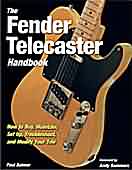 |
| Also The Fender Telecaster and The Telecaster Guitar Book of RWRP knew not . |
Some of the thousands of articles I’ve skimmed might’ve mentioned something about this, not that I’d remember, but three coffee-table tele books I acquired in a burst of late-life teleidolatry were without clue. ... So it must be this is my unique discovery which I could’ve kept secret in my heart but I will generously share with you, my invisible following, here. ... Well, secret to me and multitudes of guitar manufacturers and tinkerers, who presumably are without the power of speech or writing....
But once the electric guitar has two pickups, they can be setup two ways: right and wrong. Presumably most are manufactured the right way. And the two pickups even on cheap guitars suggests manufacturers know this, along with another clue: the two pickups should have complementary-polarity magnets — south pointing towards the strings on one, north on the other. Which doesn’t seem likely to happen by accident.
I would guess this practice represents a minimal way of evading humbucker patents, which would explain the omerta, i.e. the First Law: “don’t get sued” — and/or alternately a historical accretion, the cherished secret knowledge of underground electric luthiers passed down through years or at least months of hidden toil. ... Humbucker technology apparently originated in the 1930s, so the knowledge was out there. ... The tele switch fits either a patent-evasion theory — “see, it’s just an effect! we just accidentally wired it that way!” — and a competitive feature strategy, so idiots won’t buy the other guy’s guitar which provides soul-destroying hum and special tonal effects....

|
| I bought my tele along with a vs840ex in 1999. |
There
is a term for a properly jiggered 2nd guitar pickup: “RWRP”
aka
“Reverse
Wired Reverse Polarity”. And once you google
it, you will
find
vast seas of knowledge and ignorance, but apparently teles and other
guitars
with
RWRP pickups are common and indeed with careful scientific tests I
have verified the magnets on my
Squier Telecaster are reversed polarity bridge versus neck and I am so
happy. However my cheapo stratojunk did not
show this,![[2]](two.png) but I still figure one pickup is RW
at least
— right,
the
RW’d be $0, but RP requires a different pickup == inventory co$t. ... I notice
none
of the
astonishingly-knowledgeable authorities on the web have any opinion on
what a non-RP pickup sounds like in combination with proper RWing, but
it might be OK or phasey-cool or who knows.
but I still figure one pickup is RW
at least
— right,
the
RW’d be $0, but RP requires a different pickup == inventory co$t. ... I notice
none
of the
astonishingly-knowledgeable authorities on the web have any opinion on
what a non-RP pickup sounds like in combination with proper RWing, but
it might be OK or phasey-cool or who knows.
... And
then there’s the ~$140 (amazon 11/29/12) Electro-Harmonix
“HumDebugger”
pedal which
apparently
suppresses
the hum and
the precious single-coil
tone supposedly beloved of the faithful. ... A Youtube
somewhere depicts an uncritical enthusiast
playing typical fuzz metal rhythm riffs with and without
HumDebugger
magic and I must say, that’s my
hum he’s got, and it goes away when he presses the pedal button.
The
tone sounds the way it usually does with this kind of music — fairly
indistinguishable from noise — but of the seven amazon HumDebugger
reviews,
four
despaired at the tragic pollution of the pure single  coil
sound. ...
However
it is
cheaper than a genuine “Fender
Vintage Noiseless Tele Pickup Set” ~$160 @ musiciansfriend.com which
undoubtedly
poisons the single
coil purity since they’re apparently cute little “stacked”
humbuckers....
coil
sound. ...
However
it is
cheaper than a genuine “Fender
Vintage Noiseless Tele Pickup Set” ~$160 @ musiciansfriend.com which
undoubtedly
poisons the single
coil purity since they’re apparently cute little “stacked”
humbuckers....
The HumDebugger’s worth
every penny! I’m  undoubtedly
ripping-out
the
single-coil
soul of my Squier Tele but I don’t miss a thing — and that’s
on
the “strong” super-Republican setting. ... I set the Squier
pickup
switch
to the middle position where it doesn’t hum anyway, at least if I
don’t
provoke it, and then I stepped on the footswitch and it sounds the
same, effect on/off. If I switch to either the neck or bridge position,
it’s quite noticeably different:
lotsa buzzy hum in one footswitch position, none
in the other....
undoubtedly
ripping-out
the
single-coil
soul of my Squier Tele but I don’t miss a thing — and that’s
on
the “strong” super-Republican setting. ... I set the Squier
pickup
switch
to the middle position where it doesn’t hum anyway, at least if I
don’t
provoke it, and then I stepped on the footswitch and it sounds the
same, effect on/off. If I switch to either the neck or bridge position,
it’s quite noticeably different:
lotsa buzzy hum in one footswitch position, none
in the other....
Now
it’s perfectly true, I’m not
a guitar tone expert like the thundering web hordes. However, I didn’t
catch
any of them doing the middle-switch-position test on the
HumDebugger or, heaven forfend, a double-blind
test. ... And on the other hand, almost everything
sounds different. ... If I listened long enough (Tim
Hardin
anyone?) the HumDebugger would no doubt reveal shocking degradations as
I switched it on, even in my Squier middle switch position. But I’ve
noticed that any
change in an audio system is often detectable
by our sensitive hearing,
even perhaps including those ridiculous $10K  hifi
cables. That’s
what the double-blind
is for: you
gather as “expert” a sample of auditors as desired/feasible,
and they have to consistently assert (more than half), that
one
thing sounds better
than another — without possibly
knowing which is which. Sound
on Sound magazine, to their
credit, did
such a test with high-end
studio preamps (page 154, 10/12), and concluded that while all the SOS
guys thought
they could hear
the high-priced spread, the blind
test faked ’em out. They haven’t subsequently referred to that
test much in the $uper-preamp
“reviews”.
...
Of course,
you
wouldn’t bother with a hummy telecaster for a HumDebugger test,
but use one of those refined super humbucker
guitars — to compare only
the
HumDebugger, not the hum. ... Or, cheaper and better, just use a test
signal....
hifi
cables. That’s
what the double-blind
is for: you
gather as “expert” a sample of auditors as desired/feasible,
and they have to consistently assert (more than half), that
one
thing sounds better
than another — without possibly
knowing which is which. Sound
on Sound magazine, to their
credit, did
such a test with high-end
studio preamps (page 154, 10/12), and concluded that while all the SOS
guys thought
they could hear
the high-priced spread, the blind
test faked ’em out. They haven’t subsequently referred to that
test much in the $uper-preamp
“reviews”.
...
Of course,
you
wouldn’t bother with a hummy telecaster for a HumDebugger test,
but use one of those refined super humbucker
guitars — to compare only
the
HumDebugger, not the hum. ... Or, cheaper and better, just use a test
signal....
But regardless of all the fiddlefaddle, the HumDebugger is the obvious choice for your Fender hum suppression needs: just leave the effect off, and you get that original precious single-coil spiritual revelation, totally unaltered, as it was in the beginning and ever shall be. And a useful panorama of local electrical noise. ... Or you can engage the button, and the stupid thing stops buzzing. ... Best of both worlds, and no expen$ive anti-single-coil-tone humbucker pickups involved....
 But
I really don’t care; my iconic tele hums no more, the effect
isn’t obviously
awful and in fact is obviously better.
... I guess I just don’t got the
subtle tone sensitivities of the modern electrical guitarist; I
think this is exactly
the kind of technology Fender somehow should’ve
incorporated into their gadgets in the 21st century....
But
I really don’t care; my iconic tele hums no more, the effect
isn’t obviously
awful and in fact is obviously better.
... I guess I just don’t got the
subtle tone sensitivities of the modern electrical guitarist; I
think this is exactly
the kind of technology Fender somehow should’ve
incorporated into their gadgets in the 21st century....
And I’ve realized, after a few months and the wandering miles, that the supposedly acute “tone” sensitivity of the modern electric guitarist is really about how these silly machines all sound the same! ... Of course! ... Obviously violins or even acoustic guitars would have fairly apparent tonal differences, but the poor electric guitar, particularly the rock ’n’ roll flavor, and especially the metal/shredder/noise style? Cranked up to life-destroying volume? ... Note, if you will, that the professed tonal sensitivity appears to increase as the style of music becomes closer to the sound of garbage cans in the morning. ... So they cling to what ever more obviously doesn’t exist. ... Of course....
My web wanderings revealed how Gibson also has a supposedly-revered single coil pickup the “P90” which, sensibly, was replaced by 1958 or so with less-annoying humbuckers but are now being retro-exploited in a fashion comparable to the ridiculously solemn Fender obsequies. Helpfully, the P90 is “fat” and so can be mistaken for a humbucker. ... The Sweetwater summer 2014 catalog has a Gibson ES-390 puff (page 18?) which boasts their shabby-chic $2600 guitar with “Custom Shop P-90 single-coils” is “even wired with reverse polarity, for hum canceling when you’re using both [pickups]” — of course they mean reverse wired reverse polarity. But it was the first commercial mention of this highly obscure and controversial topic I’ve encountered, although it could’ve been in the catalog for years I suppose....
And then I heard some guy on youtube demoing three pickup flavors, and by golly yes they sure sounded different, just as if you used EQ on ’em, which I gather is a concept so advanced it escapes the general attention of the pickup obsessed guitarist. ... And be sure to see http://www.soundonsound.com/sos/nov98/articles/pickup.htm, an authoritative review/discussion which I finally stumbled on, from Sound On Sound....
 The
Shrine of
Mendacity
The
Shrine of
MendacityThen as the weary world spun, I read a few of my ridiculous telecaster books, which were pretty amusing really, and then one about the Gibson Les Paul. This guy Dave Hunter seems to be the brand leader in these things, with a Paul Balmer not far behind, and there are others: nice inside-baseball books with lots of color pictures of somebody’s favorite stars and wonderful guitars. And what started as annoying is really amazing: particularly in the Les Paul book, to discuss a guitar whose latter-day fame at least is significantly wrapped-up in its humbucker pickups, without devoting undue attention — that is, more than a 100 words in the entire book, probably more like 20 — to the minor detail that single-coil guitar pickups are noisy, and will pick up with ease the hum of a thousand transformers — this is a kind of existential poetry! ... A rhyme of untruth! ... A song. ... A saga! ...
 And I must
not omit honorable mention
for 2,000 Guitars,
which isn’t actually for sale but I bought it used at Amazon
for $15 or so, which is a tremendous bargain since it weighs a ton and
there really are
2,000 of ’em, or at least far
too many; I didn’t count, but it’s stuffed
with
color pictures + text, with some lengthy entries, for all the guitars
in the universe — not so
distinguishable
from the latest Sweetwater catalog I suppose....
And I must
not omit honorable mention
for 2,000 Guitars,
which isn’t actually for sale but I bought it used at Amazon
for $15 or so, which is a tremendous bargain since it weighs a ton and
there really are
2,000 of ’em, or at least far
too many; I didn’t count, but it’s stuffed
with
color pictures + text, with some lengthy entries, for all the guitars
in the universe — not so
distinguishable
from the latest Sweetwater catalog I suppose....
And then the 9/16 Vintage Guitar in an $1,800 Strat puff on page 138 suggested that the “infamous single-coil hum may ... be something we’ll tell our grandchildren about around the hearth”, in fulsome praise of the unit’s “noiseless” “single-coil” pickups....
 Another
Humbucker
Another
HumbuckerWhile I’m on the subject, I will mention a pickup I was inspired to acquire for $45 at Amazon: the “Dean Markely Strings ProMag Grand Pickup”. It’s a portable humbucker for an acoustic (steel-stringed of course) guitar, and has the obvious advantage of outraging swathes of the pure-tone faithful in several ways. ... Don’t confuse with other similarly-priced, at least at Amazon, Dean Markely single-coil non-humbucking pickups, presumably for the noise/hum-loving crowd.
 And
it sounded pretty good to me, plugged into a mic preamp and monitored
with headphones. A little hissy, but that could be the cheapo
preamp — well actually it’d probably sound better with an actual
instrument
input, which I just
didn’t bother. ... The gadget sort-of snuggled into the sound-hole
of my Genuine
Antique Gibson LG-1 which works
better than the description
sounds. But
the cable is mysteriously-shoddy
and permanently-attached; I plan deployment on future
imaginary acoustic recordings where it has the great advantage of
ignoring ambient noise, i.e. sirens, air conditioning, screaming, etc.
in your ridiculous attic studio
—
i.e., it’s an acoustic DI.
The cunning Markely claims to have optimized the device for acoustic
guitars, and the online reviews were as usual incensed, but I lived
through the era of wretched clip-on/fall-off/screw-on-mutilation
piezo acoustic pickups and this is infinitely easier to use and
much better-sounding. ... Your $4000 mics in your elaborately
sound-treated/isolated studio might be an improvement — but perhaps
not, if you want to record the singing guitarist in the same take....
And
it sounded pretty good to me, plugged into a mic preamp and monitored
with headphones. A little hissy, but that could be the cheapo
preamp — well actually it’d probably sound better with an actual
instrument
input, which I just
didn’t bother. ... The gadget sort-of snuggled into the sound-hole
of my Genuine
Antique Gibson LG-1 which works
better than the description
sounds. But
the cable is mysteriously-shoddy
and permanently-attached; I plan deployment on future
imaginary acoustic recordings where it has the great advantage of
ignoring ambient noise, i.e. sirens, air conditioning, screaming, etc.
in your ridiculous attic studio
—
i.e., it’s an acoustic DI.
The cunning Markely claims to have optimized the device for acoustic
guitars, and the online reviews were as usual incensed, but I lived
through the era of wretched clip-on/fall-off/screw-on-mutilation
piezo acoustic pickups and this is infinitely easier to use and
much better-sounding. ... Your $4000 mics in your elaborately
sound-treated/isolated studio might be an improvement — but perhaps
not, if you want to record the singing guitarist in the same take....
Moving on to further irrelevancies that don’t seem to fit anywhere else on my ridiculous site, in a spasm of aimless productivity I restrung my silly Tele with super-extra-light .008-.038 strings, with the strategery that if I only play a few times a decade, I should have the superlight strings at least and then it’ll play good even without calluses, which I’ll never develop again in this life most likely. ... Fat chance; it felt as clunky as ever, and measured something like 0.025’’ at the first fret, what’s supposed to be 0.010’’, according to a fender book and fender.com.
... After years of concentrated philosophizing, I realized my crummy latter-day Squier telecaster rendition was better: it doesn’t have the stupid thing where the strings have to be inserted through the body! ... I’m sorry to break it to the innocentés out there hanging upon my every word, but that was just cheap — it was cheaper to secure the strings that way. And obviously more annoying. But of course a sacred requirement of the genuine true Fender....
 Nut Height
Nut HeightAnd it’s obvious the nut’s too high on my cheapo imitations. As they always were in the old distant dreamy days, when I went through endless pitiful $0 struggles to make them righteous, which never happened and I will not repeat or repent. ... This time I’ll buy another nut (just search amazon for “telecaster nut” and there’s a page of em’! ~$10!), wreck the current one most likely, and the truss, and fiddle the bridge....
You will see, oh hostile twisted guitar fates! As I shake my powerless fist at the empty ceiling. ... In a subsequent field expedition to Guitar Center, I noticed all the guitars below $200 or so had nuts with the strings held-up proud and high like my humble Squier, and all the expen$ive guitars had much lower strings at the nut — the difference is easily visible. ... Apparently cutting a ~0.015’’ sliver from the bottom of the nut is a major cost component in modern guitar manufacture.
... Then again, perhaps I will test-abuse my innocent
StratoHannah  —
it’s got a kiddiesque short neck, which’ll make my ridiculous
.009 strings even wimpier....
—
it’s got a kiddiesque short neck, which’ll make my ridiculous
.009 strings even wimpier....
 The
Zero Fret
The
Zero FretAnd I should note that in the weary wandering months a
few sources have blown the gaffe a bit by mentioning the zero
fret — first,
as a despised accoutrement of old junky “European” guitars
but
then
later, one of the fancy guitar magazines foolishly carried a column by
some guy who fixed-up a crummy guitar by, among other luxury fittings,
putting some kind of nut-with-zero-fret assembly on it as a high class
upgrade. ... This “zero fret”, if it’s not obvious, is
a
fret below
the
first fret, i.e. right where the nut is, that provides an uncomplicated
string height arrangement without
precision delicate nut adjustment. And, consequently, making it much
harder to produce an “expensive” and a  “cheap”
guitar on the same assembly lines. ... And, hey, apparently a 2015
upgrade for Gibson is ... an “adjustable
zero fret nut”! Of course the Gibson thing is all pure and
Jetsons,
nothing like that eurotrash....
“cheap”
guitar on the same assembly lines. ... And, hey, apparently a 2015
upgrade for Gibson is ... an “adjustable
zero fret nut”! Of course the Gibson thing is all pure and
Jetsons,
nothing like that eurotrash....
These amazing observations, incidentally, have convinced me at least to never buy another guitar without seeing the nut string height — interesting full-employment project there for brick ’n’ mortar music stores — or gain guerilla expertise in nut mutilation. Or perhaps just always play with a capo on the first fret, and maybe tune the strings down a half tone. ... Of course I wasn’t planning on buying another guitar anyway; I’m going to win one of those contests the guitar magazines relentlessly flog in my email.
Anyway, my great triumph was, after a decade of keeping the thing in tune by ear and an occasional low E clonk on one of my silly keyboards, and after changing the strings, keeping it tuned-up while I went along — good for the tension you know — as the beautiful illustration shows, a genuine scientific machine said the E was still right on the money! ... It’s like John Henry and that steam drill....
Yeah and no wonder these drug-addled guys have guitar techs! ... To get the string into and through the bridge, I had to bend it up a little bit at the front, and then hold it with a clamp pliers or else it would infallibly twist itself in the wrong direction and wouldn’t get out the right hole. And when I unclamped, the pliers wanted to “clonk” the shiny finish, so I had to do it with a towel. ... And up at the head end, it’s only a little easier, requiring serious attention to the wandering tendencies of silly springy metal. ... No walk in the park no sirree. And I’m in the middle of bright lights, spacious tables, and a ridiculous over-abundance of tools....
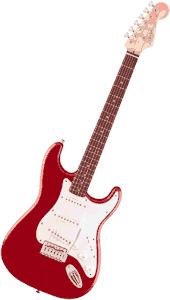 End
Times: My Stratocaster
End
Times: My Stratocaster Thu
9/12/24. As I stumble into the blinding future, I decided my
obviously deranged collection needed a stratocaster — but, of course,
a
genuine cheap imitation
Squier (the official Fender off-brand) strat.
And sadly the pitiful machine came with an ugly sticker which I
complained about at amazon, posting, I think, my first amazon picture.
As I told my no-doubt attentive audience, the thing didn’t seem to
want
to come off with my thumbnail, and then I figured maybe that is
the right fender
look for the new age....
Thu
9/12/24. As I stumble into the blinding future, I decided my
obviously deranged collection needed a stratocaster — but, of course,
a
genuine cheap imitation
Squier (the official Fender off-brand) strat.
And sadly the pitiful machine came with an ugly sticker which I
complained about at amazon, posting, I think, my first amazon picture.
As I told my no-doubt attentive audience, the thing didn’t seem to
want
to come off with my thumbnail, and then I figured maybe that is
the right fender
look for the new age....


|
Acoustic and
electric guitars are fretted instruments and, as most players’ll
find
out sooner or later, are constitutionally out of tune. Obviously a
skilled player can make up for much, but the frets’ tempered scale
will
inevitably clash in various 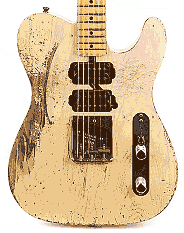 amusing ways with
the string tuning. As an
unskilled player on so
many instruments, I can testify that the amateur in-tune effect of
almost any
keyboard is vastly superior to the guitar and indeed popular music
favors screaming monophonic lead guitar with the chord background
typically supplied by what is tellingly described as the rhythm
guitar. Both
of course @ physically destructive loudness + distortion. Not
just a
coincidence. ... The golden age of the gentle folky provided
less annoying, more musical effects, and indeed the acoustic guitars were played
in tune occasionally, but only by talented experts, however otherwise
childish
they may have been.
amusing ways with
the string tuning. As an
unskilled player on so
many instruments, I can testify that the amateur in-tune effect of
almost any
keyboard is vastly superior to the guitar and indeed popular music
favors screaming monophonic lead guitar with the chord background
typically supplied by what is tellingly described as the rhythm
guitar. Both
of course @ physically destructive loudness + distortion. Not
just a
coincidence. ... The golden age of the gentle folky provided
less annoying, more musical effects, and indeed the acoustic guitars were played
in tune occasionally, but only by talented experts, however otherwise
childish
they may have been.
Fretted instruments historically appealed to the cheap and incompetent: they can be played kind-of in tune with relatively little skill. In our age of opulent luxury this is obsolete but still a cherished myth, evoking poverty-stricken artistes & high poetry. People believe — I used to believe — if the guitar’s action is properly “set-up” — i.e. not ridiculously high as typically provided for the cheap seats — then the guitar’ll play in tune. In this way, the industry can sell perhaps one more guitar to the ignorant, and a more expensive one....
... “The guitar is the easiest instrument to play and the hardest to play well” —Andrés Segovia (delivered in a premier guitar email).
 $35
Muslady Wireless
Guitar System Doesn’t Work
$35
Muslady Wireless
Guitar System Doesn’t WorkWhile one is tinkering pointlessly with one’s electrical instrument, that stupid cable is annoying, and for $35 ebay sold me this “2.4G Wireless Guitar System Transmitter & Receiver Built-in Lithium Battery I8P8” with free shipping! which, oddly, seemed to work great! Amazon of course has it too, if they feel like delivering things this week. Sweetwater wouldn’t dirty its toes with it, selling many no-doubt much more reliable systems for vast sums, and I certainly wouldn’t want to trust this gadget for any commercial purpose. But in the music dungeon it’s charming. ... Except when I noticed it thoroughly jammed my wifi. So the technology has been retired in disgrace at the laboratory....
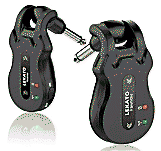 But
$60 Lekato
5.8 Wireless Guitar System Works Great!
But
$60 Lekato
5.8 Wireless Guitar System Works Great!Like the song says, “all you need is money, money, money”, in this case a pittance more to get a system that doesn’t jam my wifi. Of course it’d probably jam yours — if it feels like it. ... So there’s two home wireless “bands”, the original old hopelessly-outdated 2.4 GHz, and the new improved 5 GHz. I gather, mostly by psychic links, that the 2nd frequency is to enable the sad prisoners of the cubicle cities to perhaps use their wifi without being crushed by their giant cubicle building’s neighbors’ wifis — I think the mechanism is automatic, so it’ll slither around a bit and perhaps connect successfully, where the old boring 2.4 GHz couldn’t. And the triumphant Lekato specifies it’s got both — and the pitiful muslady and similarly-priced junk only got the 2.4GHz.
... My beautiful guitar tones are now ejected from my pitiful little amplifier without wires! Although at first I was fooled by clicks & silence — a cunning dirty pickup switch, probably, sneaking in to help-out the wireless failure and torment the pitiful technical aged person — but dexoit made all joy....
 Semi
Hollow
Semi
Hollow
 At
last
(12/26/19) the laboratory has acquired a
genuine cut-rate amazon $160
2019
New Product GROTE BRAND Semi Hollow Body Electric Guitar (VS)
so I can rock-out with the kool kids in degraded abandon — I snarl
with derisive contempt. ... But really, it is
beautiful. Before touching a string in anger, its appearance
was
gratifying:
large, substantial. I figure the hollow-body popularity in rock/metal
is at least partly the EZ feedback shrieks, but the bigness is probably
a
factor. ...
Originally I was inspired by the similar “Firefly” at amazon
for
$10 less, but I dawdled and
it disappeared, accompanied by
anguished internet complaints, but an amazon Grote
reviewer opined it was just as good as the firefly, which he had also
acquired. ... And then at 1/3/20, the Grote in its turn was gone!
At
last
(12/26/19) the laboratory has acquired a
genuine cut-rate amazon $160
2019
New Product GROTE BRAND Semi Hollow Body Electric Guitar (VS)
so I can rock-out with the kool kids in degraded abandon — I snarl
with derisive contempt. ... But really, it is
beautiful. Before touching a string in anger, its appearance
was
gratifying:
large, substantial. I figure the hollow-body popularity in rock/metal
is at least partly the EZ feedback shrieks, but the bigness is probably
a
factor. ...
Originally I was inspired by the similar “Firefly” at amazon
for
$10 less, but I dawdled and
it disappeared, accompanied by
anguished internet complaints, but an amazon Grote
reviewer opined it was just as good as the firefly, which he had also
acquired. ... And then at 1/3/20, the Grote in its turn was gone!
... But as with all the guitars, playing wasn’t a wonderful exciting dreamlike experience — which the expen$ive brands must infallibly supply, but I will never know. ... And I am equally certain/ignorant that the expensive brands sound so wonderful they would immediately be recognized as such by the usual blind-folded fool....
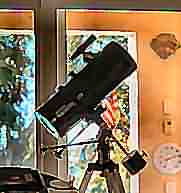 After
years of careful observation, I have
concluded the adoration of the sacred guitar is less
offensive than the pitiful let’s-all-support-science-kids
Telescope
cult. Both
are
puffed on the web with near total BS
and the
same gull-the-customer objective, but the guitars with occasional
bizarre
exceptions don’t
tout Holy
Science
as a reference, claiming only extravagant beauty for the absolute
certainty of their beatitudes. ... And of course the guitars
occasionally make beautiful music, although normally they are devoted
to “telling it to the man” as offensively as possible....
After
years of careful observation, I have
concluded the adoration of the sacred guitar is less
offensive than the pitiful let’s-all-support-science-kids
Telescope
cult. Both
are
puffed on the web with near total BS
and the
same gull-the-customer objective, but the guitars with occasional
bizarre
exceptions don’t
tout Holy
Science
as a reference, claiming only extravagant beauty for the absolute
certainty of their beatitudes. ... And of course the guitars
occasionally make beautiful music, although normally they are devoted
to “telling it to the man” as offensively as possible....
I should emphasize that the most important factor in playing the fretted guitar — or any string instrument, probably — is calluses, on your fingers — of the left hand, if you’re right-handed. ... As I note somewhere above, I don’t got ’em, and probably won’t again in this life, because they require constant guitar playing! ... What a drag, eh?
— 3/21
 1.
Eventually I happened to read in one of these shoddy
guitar magazines that the strat switch does
bridge+middle and
middle+neck — fender
explains
it like
1.
Eventually I happened to read in one of these shoddy
guitar magazines that the strat switch does
bridge+middle and
middle+neck — fender
explains
it like
Position
1: Bridge
pickup only.
Position 2: Bridge pickup and middle pickup together.
Position 3: Middle pickup only.
Position 4. Middle pickup and neck pickup together.
Position 5: Neck pickup only.
But that’s today’s strat. The fender article continues to explain that the original strat had a 3-way switch which’d turn on each of the three pickups alone; nothing else. Which led to players’ well-known “trick” where they’d “nudge” the switch to get the “middle” positions, like positions #2 and #4 in the modern strat. Presumably the hum-bucking positions, if the middle pickup’s wired RWRP to the other pickups, which I’m pretty sure it is, even if googling “stratocaster RWRP” does turn-up suspects who think the middle pickup is configured non-RWRP so any position of the strat switch’ll still pick-up all that lovely hum & noise and Holy pure single-coil tone. But googling “telecaster RWRP” also finds pilgrims who complain about their tele being that way, accuse strats of the heinous fault, and others who say the holy original tele wasn’t — which last I’m willing to believe, but I know for a fact my cheapo Squier tele is RWRP, so I’m just going to assume all the web witnesses are ignorant fools. ... My shoddy guitar magazine article was actually morally superior and did mention noise, but hum and noise are entirely absent, of course, from the fender article, which insists that players’d do that “trick” to get a different tone — where I suppose “different” could mean, “not burdened with the hum of a thousand transformers”. ... Anyway, this is why the guitaritariat take-up the strat in preference to the tele: two anti-hum positions, + 3 total hum & noise, as opposed to the pitiful tele’s one and two. ... Or, translated into the liar-ese of the industry, “that super hot strat tone”. ... And, I would note, the strat would doubtless also benefit from a little hum debugger magic....
 2.
The <$20 Stewart-MacDonald “Schatten Magnet Polarity Tester”
is a
little plastic tube with a jiggly magnetic ball of plastic in it, which
I could poke at my cheapo telecaster lying on a table and determine
that one of the pickups was “N” and the other “S”,
just as I had
already concluded by cruder means. But the gadget came with a brochure
which
insisted that all telecaster pickups were from “the mid 50s”
both
south-up — so much for snooty omniscience. Although of course my
beloved tele is not
a Fender, but a tawdry Squier, so maybe the fenders are all crippled
like that, but I doubt it. ... And my stratojunk
had pickups
with the same magnetic polarity, as I suspected....
2.
The <$20 Stewart-MacDonald “Schatten Magnet Polarity Tester”
is a
little plastic tube with a jiggly magnetic ball of plastic in it, which
I could poke at my cheapo telecaster lying on a table and determine
that one of the pickups was “N” and the other “S”,
just as I had
already concluded by cruder means. But the gadget came with a brochure
which
insisted that all telecaster pickups were from “the mid 50s”
both
south-up — so much for snooty omniscience. Although of course my
beloved tele is not
a Fender, but a tawdry Squier, so maybe the fenders are all crippled
like that, but I doubt it. ... And my stratojunk
had pickups
with the same magnetic polarity, as I suspected....

